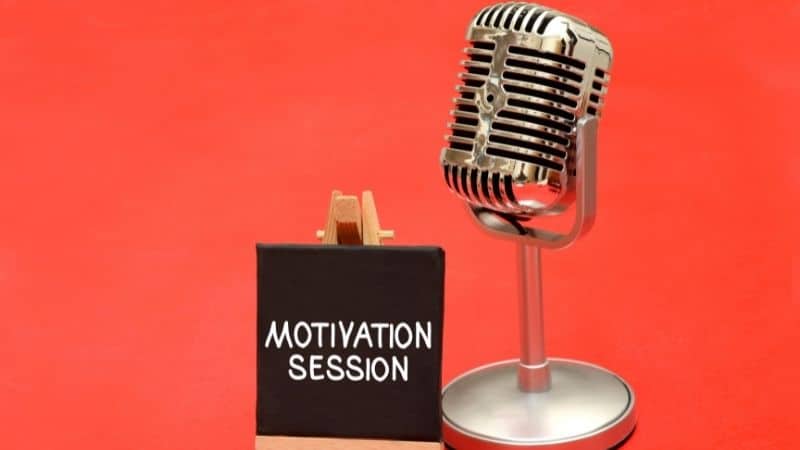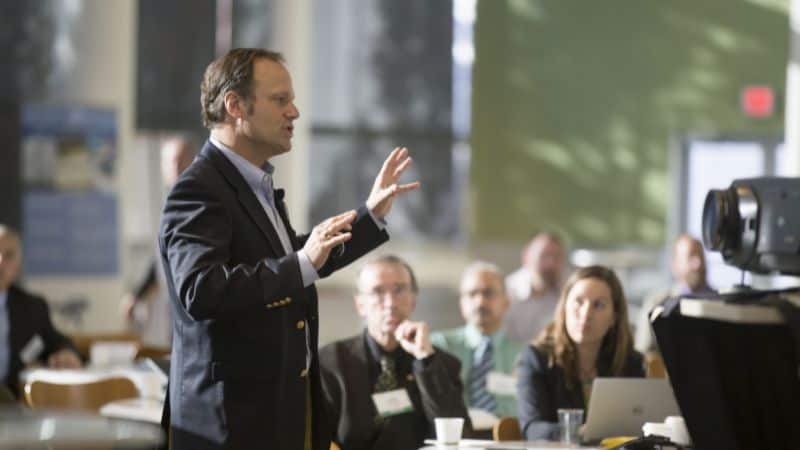I’ve been invited to speak to executives in Makati boardrooms, to teachers in crowded school halls, and to frontline workers in small towns across the Philippines. Each audience was different, but their hunger was the same: they weren’t just looking for inspiration. They wanted a reason to act.
That’s the real measure of a motivational speech.
I remember following a well-known speaker once. He was funny—full of punchlines and quotes from famous men, most of them dead. The audience laughed. They applauded. But when he left the stage, there was no clear message to hold on to. People were entertained, but not moved.
When my turn came, I knew I couldn’t compete by being funnier. Instead, I focused on being clear. I told one story, anchored in truth, and connected it to the real challenge that audience was facing. That’s when I saw heads nodding. That’s when I saw people leaning forward.
I share this story because too many people think motivational speeches are about hype, humor, or performance. They are not. A real motivational speech must flip a switch—helping people see their challenges differently, giving them courage to act, and moving them one step closer to their goals.
This short article comes from my own journey as a professional motivational speaker. My hope is simple: that what I’ve learned onstage can help you—whether you’re preparing to give a talk, organizing an event, or simply curious about what makes a motivational speech worth paying for.
Because the secret is not in the punchlines. It’s in the power to create change.
What Is a Motivational Speech?
At its core, a motivational speech is a talk designed to inspire people to act, to change a behavior, or to pursue a goal with renewed energy. It is not just about filling time with clever words. It is about flipping a switch inside the listener so that they leave the room ready to do something they once thought impossible.
This is different from a lecture, where the goal is to transfer information. It is different from stand-up comedy, where the goal is laughter. A motivational speech may inform and may entertain—but its true purpose is transformation.
I learned this distinction the hard way. Early in my career, I thought being a motivational speaker meant telling stories, quoting famous thinkers, and raising my voice at the right moments. It felt good in the moment. But later, I realized: people didn’t just need to feel good. They needed to feel moved.
That’s why in my talks—whether I’m speaking to a group of managers in Manila, government officers in Mindanao, or students in a rural town—I always return to the same principle I share in Create Your Stage: motivation must lead to motion.
If a speech makes people laugh but leaves them unchanged, it has failed. If it makes them clap but not commit, it has missed its mark. But when a speech makes someone whisper to themselves, “Yes, I can do this”—that’s when the work of a motivational speaker is truly done.
This is why companies hire motivational speakers. Not to entertain their people for an hour, but to help them see their challenges in a new light, believe in their own capacity, and take the first step toward change.
What Motivational Speakers Really Do (and Don’t Do)
There are so many myths about motivational speaking. Some of them are entertaining, but they are also dangerous—because they give organizers the wrong expectations, and speakers the wrong goals. Let’s clear them up.
Myth 1: Motivational speaking is about being funny.
I once followed a popular speaker at a conference. He was hilarious—every paragraph ended with a punchline. People laughed and applauded. But when the laughter faded, what was left? No clear message. No solution. Just jokes.
Humor can make a talk enjoyable, but motivation is not about laughter. It’s about giving people courage to act.
Myth 2: Motivational speaking is about quoting famous people.
It’s easy to fill slides with quotes from Gandhi, Einstein, or Steve Jobs. Many do. But an audience doesn’t need another recycled line. They need a message that speaks to their own lives.
The best motivational speeches don’t just repeat wisdom from others. They connect personal stories and real solutions to the challenges in front of the audience.
Myth 3: Motivational speaking is about hype.
Some speakers mistake volume for impact. They make people jump, clap, or shout affirmations. It looks powerful in the moment, but the effect disappears once the music stops.
A real motivational speech goes deeper than hype. It addresses people’s challenges, uncovers causes, offers a path forward, and gives them courage to walk it.
Myth 4: Motivational speakers are just entertainers.
It’s tempting to think of us as performers—people who go on stage to impress and leave. But if all we do is entertain, then we’ve missed the point.
A motivational speaker’s role is to put the spotlight on the audience’s challenges, and then guide them to see a way through. As I wrote in Create Shifts: “A speech that does not change people’s behavior is just noise.”
Motivational speaking is not about hype, humor, or borrowed wisdom. It is about helping people believe in the beauty of their dreams—and giving them the courage to take the next step.
The Psychology of Motivation (Why People Act)
The word motivation comes from the root motive—the reason for action. People don’t act randomly. They act because something inside them pushes or pulls them toward a goal. Even employees labeled as “unmotivated” aren’t really without motivation. They are simply motivated to do something else, something they find more rewarding than what the company is asking of them.
For decades, organizations have relied on the old carrot and stick method: reward good behavior, punish bad behavior. And while it works in some situations, it doesn’t always lead to lasting change. That’s why companies bring in motivational speakers—to spark something deeper than compliance.
Here’s the truth I’ve seen after speaking to thousands of people:
- Logic alone rarely moves people. You can present all the data, and still no one changes.
- Fear works, but only for a while. People may act out of pressure, but it doesn’t build commitment.
- Stories persuade best. When people see themselves in a story, they imagine new possibilities.
That’s why in my keynotes, I don’t just present tips or techniques. I tell stories that carry a rhythm of real transformation:
Desire → Disaster → Decision → Direction.
- Desire: What people want.
- Disaster: The challenge that stands in the way.
- Decision: The moment they choose to act.
- Direction: The new path that choice creates.
This story arc works because it mirrors real life. Every person in the audience has known desire. Every person has faced disaster. And when they hear how others made a decision and found a new direction, they start to believe they can too.
This is the psychology of motivation. It’s not about forcing people to act—it’s about unlocking the motives they already carry and showing them a way forward.
The Business of Motivational Speaking in the Philippines
Motivational speaking is not just about inspiration. It is also an industry. And like any industry, it has its myths, its practices, and its realities.
How Much Do Motivational Speakers Get Paid?
In the Philippines, fees range widely:
- Newbies often speak for free, or for a token honorarium—sometimes just a bottle of wine or a meal.
- Freelance speakers may charge ₱5,000–₱10,000 for a short talk.
- Professional speakers with proven track records charge ₱20,000–₱40,000 per keynote.
- Industry experts and sought-after keynote speakers can command six to seven figures for major conventions and conferences.
Yes, those numbers surprise many. But here’s the key insight: companies don’t pay for words. They pay for results.
Canned vs. Customized
Some speakers rely on “canned” speeches, delivering the same script word-for-word everywhere. Others promise “tailor-fit” customization. But in practice, what matters is not whether the talk is new—it’s whether it solves the audience’s real problems.
I’ll never forget one lesson that shifted my own career. After a 90-minute keynote on Reinventing Leadership for a Philippine bank, the Chairman doubled my fee. Then the new president pulled me aside and said: “Don’t change a thing. I want my people to hear the exact same speech.”
At first, I was shocked. I thought real professionalism meant constant customization. But I realized he was right. What mattered wasn’t variety. It was value. The message worked, and he wanted it to work for everyone.
Why Clients Book Speakers
Companies invest in motivational speakers for three main reasons:
- Boost morale when energy is low.
- Encourage adaptability when change feels overwhelming.
- Inspire innovation when people get stuck in routine.
When they book you, they are not just filling a slot in the program. They are making a strategic investment, hoping you will flip the switch that their internal managers have struggled to flip.
The business side of motivational speaking is often misunderstood. It’s not about flashy websites or bold claims of being “the best speaker in the world.” Those may get you noticed, but they won’t sustain a career. In the end, the only thing that keeps you on stage is this: your ability to deliver results that matter.
What Companies Expect From Motivational Speakers
When organizations bring in a motivational speaker, they’re not just buying an hour of stories. They’re making an investment. And like any investment, they expect a return. From my work with companies across the Philippines, here are the three results they hope to see:
1. Boost Morale and Engagement
I’ve spoken to employees who were burned out, tired of targets, and feeling invisible in their own organizations. A well-crafted keynote can act like a reset button—reminding people why their work matters, reigniting pride, and giving them the energy to show up with purpose again.
When morale is high, engagement follows. People feel valued, and productivity rises. This is often the first win leaders look for when they call me in.
2. Encourage Change and Adaptability
Change is the one constant in every organization—and yet it’s the thing most people resist. I remember speaking to a company that had just gone through a major restructuring. The air was heavy with uncertainty. My role wasn’t to sugarcoat the change, but to help people see it as opportunity.
A motivational speech can give people courage to adapt, not just endure. It can help them reframe challenges as stepping stones instead of stumbling blocks.
3. Inspire Innovation and Creative Thinking
Sometimes, organizations get stuck in routines. People do their jobs but stop asking, “What if?” That’s when innovation dies. A powerful talk can open that door again.
I’ve seen teams walk out of a session ready to pitch new ideas, challenge old processes, and explore fresh solutions. That spark of creativity often comes when people feel safe to think differently—and a motivational speech can help create that shift.
At the end of the day, companies don’t hire motivational speakers for entertainment alone. They hire them to see these results: morale lifted, change embraced, and creativity unlocked.
That’s what I aim for in every talk I deliver. If you’re looking for that kind of impact in your next event, you can learn more about my approach here: Motivational Speaker Philippines.
How to Deliver Motivational Speeches That Get Results
A motivational speech doesn’t succeed by accident. It succeeds because it is designed to create a shift in people’s thinking and behavior. Over the years, I’ve refined an approach that consistently works—not just to inspire, but to move people.
Here are five keys to delivering motivational speeches that get results:
1. Start With Clarity
Before you step on stage, ask yourself: What’s the one message I want people to take home? Don’t aim for a dozen lessons. Aim for one idea sharp enough to stick. As I wrote in Create Your Stage: “Say something true.”
2. Tell Stories That Create Moments
Information informs. Stories transform. But not every story works. A motivational story needs tension (the struggle), stakes (what’s at risk), and a shift (what changed). That’s why I use the arc: Desire → Disaster → Decision → Direction. Stories built this way create moments that audiences remember long after the applause.
3. Flip the Switch
A motivational talk must create urgency. People need to feel the danger of staying the same—and the promise of what change can bring. This doesn’t mean scaring people. It means painting a clear contrast between what will happen if they act, and what will happen if they don’t.
4. Anchor to Behavior
Motivation without motion is useless. Always point people toward a behavior they can practice immediately. Whether it’s “own the result,” “start before you’re ready,” or “ask a better question”—give them something concrete to act on.
5. End With a Charge, Not Just Applause
Too many talks end with “thank you.” But the best ones end with a charge—something that makes people sit taller and whisper, “I can do this.” The goal isn’t clapping hands. It’s committed hearts.
When you follow these five keys, your motivational speech doesn’t just inspire for the moment. It plants a seed of action that grows long after you’ve left the stage.
As I often remind new speakers in Create Shifts: “Motivation is not the end. It is the spark. The real measure is what happens after the room empties.”
Why Some Motivational Speeches Fail (and How to Avoid It)
Not every motivational speech works. I’ve sat in audiences where people politely clapped at the end but walked out unchanged. I’ve even followed speakers who drained the energy in the room before I took the stage. The truth is, motivational speeches fail for predictable reasons—and every one of them can be avoided.
1. Too Self-Centered
Some speakers treat the stage as their autobiography launch. They spend half an hour talking about themselves, their struggles, their awards. The audience leaves asking: “What does this have to do with me?”
Fix: Share your story only as a bridge, not the highway. Make it connect to their challenges, not just celebrate yours.
2. Too Long
I once sat through a keynote that stretched beyond an hour. By minute thirty, people were restless. By minute fifty, they were gone—mentally, if not physically.
Fix: Keep it short. Seventeen to thirty minutes is enough for most motivational speeches. Brevity is not weakness—it’s clarity.
3. Too Shallow
Some speeches are all hype: loud music, shouting, people jumping and clapping. It looks powerful, but the effect evaporates once the lights dim.
Fix: Go deeper. Name the real challenges. Offer a path forward. Let motivation lead to motion.
4. Too Generic
The easiest way to lose an audience is to sound like you could be speaking anywhere, to anyone. “Reach for your dreams.” “The future is in your hands.” These clichés wash over people without touching them.
Fix: Be specific. Use real stories—about their industry, their struggles, their people. Make them feel seen.
When motivational speeches fail, it’s not because people don’t want to be motivated. It’s because the speaker forgot the core principle: the spotlight belongs to the audience, not to you.
If you avoid these traps—self-centeredness, length, shallowness, and vagueness—you’ll already be ahead of most speakers who call themselves “motivational.”
Becoming a Pay-Worthy Motivational Speaker
Not every motivational speaker gets paid. Many start by speaking for free in churches, schools, or community events. Some accept honorariums—a meal, a bottle of wine, or a token fee. And there’s nothing wrong with starting that way. But if you want to build a sustainable career as a professional speaker, you need to understand what makes people willing to pay.
For Aspiring Speakers: Focus on Value, Not Variety
The quickest mistake new speakers make is thinking they need a brand-new speech for every audience. That’s exhausting—and unnecessary.
What companies and communities really pay for is results. They want a shift in behavior, a spark of courage, a solution to a real problem. That’s why some of the world’s most respected speakers—like Russell Conwell with Acres of Diamonds—delivered the same talk thousands of times. It worked.
If you’re just starting out:
- Build one signature talk around a real solution.
- Refine it with every delivery until it’s razor-sharp.
- Anchor your pricing not on the length of your talk, but on the value it creates.
Remember: people may pay you once for novelty, but they’ll pay you again and again for impact.
For Leaders and Organizers: Choose Speakers for Solutions, Not Slogans
When hiring a motivational speaker, it’s tempting to ask, “Will you customize this for us?” But the better question is: “Will this talk move my people?”
A pay-worthy speaker is not the one who sprinkles your company’s name into their slides. It’s the one who understands human motivation, tells stories that create urgency, and leaves your people with the courage to act.
That’s why, when leaders ask me to speak, I always clarify: I’m not just here to entertain. I’m here to create a shift—whether it’s boosting morale, encouraging adaptability, or inspiring innovation.
If that’s the kind of impact you’re looking for, you can learn more here: Motivational Speaker Philippines.
Your Speech Must Flip the Switch
At the end of the day, a motivational speech is not about clever punchlines, viral quotes, or even standing ovations. Those are nice, but they are not the goal.
The true purpose of a motivational speech is simple: to flip the switch.
To help someone see their problem differently. To remind them that their dreams are still worth chasing. To give them courage to act—today, not someday.
That’s the work. That’s the calling.
Over the years, I’ve spoken to executives in high-rise boardrooms, students in rural schools, and workers in crowded factory floors. The settings were different, but the task was always the same: not to impress, but to ignite.
So if you are an aspiring speaker, remember this: don’t measure your success by applause. Measure it by action. If even one person leaves your talk ready to take a step they’ve been avoiding, you’ve done your job.
And if you are a leader or event organizer, don’t hire a speaker for slogans. Hire them for solutions. Look for the one who won’t just make your people laugh for an hour, but will help them live differently afterward.
Because in the end, motivation is not the finish line. It’s the spark. The real journey begins the moment the room empties and people decide to move.
That’s what every motivational speech must do. It must flip the switch.







